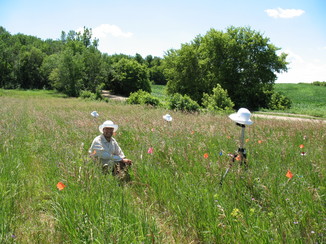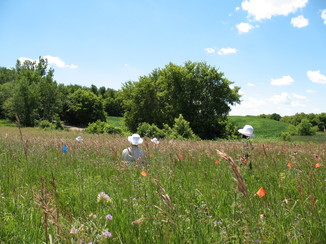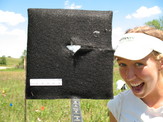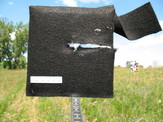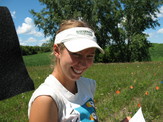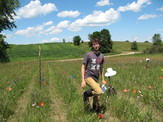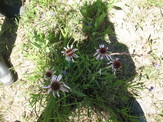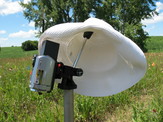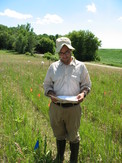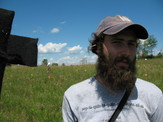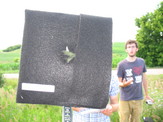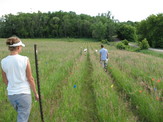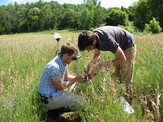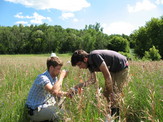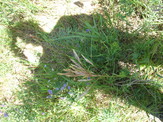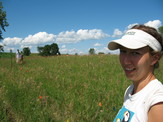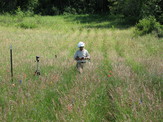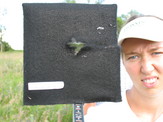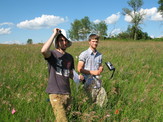|
|
Kite Aerial Photography is not going well. Friday the 13th was a particularly bad day.
MORNING: In the morning Josh, Julie & I drove to NNWLF. We set out ground markers and got the kite up. After we got the camera up we realized that the remote control wasn’t going to gain us much with the canon S70 because it take about 10 seconds between shots in the RAW mode. The interval on the timer is about 15 seconds. Then the camera battery ran out ARG. So, we went back to lunch.
AFTERNOON: Armed with fresh batteries we went back to NWLF and set out the ground markers, got the camera up, and took a lot of shots. Or so we thought. When we returned I found that there were no photos on the card. We’re not sure what happened. Perhaps the LED didn’t trigger the sensor. The problem was we didn’t check. ARG.
EVENING: Julie & Josh painted the kite line at 10 meter interval, so we could gauge the height of the camera. When the paint dried, I went out the roll up the string and found it was in four pieces. Some animal had chew through the line in several places. ARG.
Well, we are learning a lot. We have a long way to go before we are a well-oiled KAP machine.
Of course there was a fine finish to the day. I was working on the computer and got distracted for a few minutes. Then I heard thunder in the distance and the power went off for a few seconds. I lost the first version of this lament. I then pulled the plug on all computers and went to bed.
It was Friday the 13th, the kind of day the superstitious worry about and the kind that I figure is just another day. The wind was pretty good, enough to pick up our Flowform 16 kite with our camera rig. We went out to North by Northwest of Landfill and set out our ground markers [images when our internet gets back up]. With a pretty good wind from the west, we got the kite up and the camera rig above the roadside population. We took two runs along the road, once south and once north (higher and lower). Overall, it was a good run.
Until…
Until we plugged the camera into the computer. No images. Hrm.
We were using a new setup that day. Stuart had bought a radio-control set that we hooked up to the camera. It seemed to work just fine at the farmhouse… but not at the site. At this point, Julie and I were painting the kite string (so we could tell how much line was let out). Testing the RC stuff again, it SHOULD have worked fine. We’re not sure why it didn’t.
Cut to the next day. We left the string out to dry when we left in the evening and between our departure and Stuart’s taking the line in a few hours later, some cheeky rodent decided that our artificial string would be a tasty snack and gnawed through it in a few places. Friday the 13th strikes again.
And now today. The 200-lb test line has been painted and is currently drying. I’ve worked out one of the problems with our camera rig (before, the camera would take a picture all the time: all that was needed was putting it on a different control stick. [images for clarity later]). I can now control both the Canon S70 and the new Canon Digital Rebel XTi (with The Nifty Fifty, a 50mm prime lens. It’s a touch long, but our benefit in megapixels and in general quality should be worth it) with the press of a control stick.
Here are some notes including completed management and what’s left to do…
7/12/07 2:10 pm
The crew did a great job weeding Melilotus & Carduus yesterday and the day before. Very thorough job! They started cutting woody veg. Ash and Sumac are prevalent. Some others woody species include Salix, Rubus, Vitis, Ulmus. I looked where the single Toxicodendron plant used to be. No sign of it. I haven’t seen it for several years.
I systematically walked the garden looking at these groups of rows: 56-51, 50-47, 46-43, 42-39, 38-35, 34-31, 30-27, 26-23, 22-19, 18-15, 14-11, <11, >56. I was searching for Lotus and gopher mounds.
7/12/07 3:13 pm
I removed Lotus corniculatus from these locations…
row pos
52-53 905-906 veg removed
54.5 973 veg removed
48 908.5 pla removed
29.5-30 872.5-873 plas & veg rem
17 954.5 pla rem
18 955 veg rem
I noted gopher mounds at these locations. Not all of these are active. I think there are many more ground squirrels than pocket gophers.
row pos
55.5 981.5
45.5 924
43.5 925
43.5 926.5
43.5 930
43 930
44.5 931
46 983
42.5 930
42.5 928
42 948
40.5 923
39.5 921
39.5 916
36.5 921
36 927
37 928
36.5 929
34.5 932
36.5 985
37.5 985
36 983.5
33.5 983
33 932
26.5 912
16.5 885
56.5 915
Note: a huge Thamnophis radix emerged from a hole at 28 940.
In the future–make a plant species list for the common garden. Here are some notes:
Helianthus sp & Galium boreale at 12 889
Stachys palustris in r16 p885
Lathyrus venosus & Galium boreale at r55-56 p970-973
Oenothera biennis at r9 p880
Spirea alba r 57 p973
What is that cf. caprifoliaceae on e side?
TO DO LIST ————
Continue cutting woody veg.
Staple 98 garden.
Remove thistles on W edge.
Remove Phalaris patch r38-39 p~875.
Cut trees in ditch.
Girdle trees E of CG.
Make ladder stairs for S entrance.
Remove Cottonwoods from ditch.
Remove fenceposts.
Remove rebar posts & put in posts along edge.
Put signs along road (& E side?).
Intall webcam.
——————————
On 5 July 2007 Amy & Gretel found a harvested head in a bag from last year. They brought in the bag. Here’s their note:
Mp0418
hdandbag
many achenes loose
many seedlings
25-972 flagged
16 seedlings at least
I noted the coordinates for seedling cluster:
r25.29 p971.63
and there’s 1 seedling 13 cm NE’N of main cluster.
the internet is down at Andes! and it has been for a week. Hopefully it will be fixed soon. Hopefully today
The Federal Highway Administration is seeking input about how to prioritize research on highway corridors and the environment (e.g vegetation, wildlife, wetlands, endangered species, brown fields, and water quality).
If you have any ideas, send them a comment.
They are interested in comments on big ideas, not proposals, before AUGUST 24, 2007.
I think we need to know more about how corridors of native plants along highways affects bees and other pollinators, including threatened insects. Also, does planting hardy native plants save money by reducing mowing and weeding costs? Do native plantings make driving a more pleasurable experience?
I’m also curious about the effect of planting native plants in highway corridors near native remnant prairies. On one hand, larger plant populations might improve the survival of plants and animal in the remnants by increasing the habitat area and expanding pollinator populations. On the other hand, planting non-local seed sources next to a prairie remnant might introduce genes into the local remnants that might reduce plant performance (growth, disease resistance, etc) and possibly hasten the demise of a plant population in the native remnant.
We haven’t been blogging for quite a few days now because the internet has been down at Andes. Apparently the technician from Gardonville Cooperative Telephone Association couldn’t figure out what’s wrong, so he went home.
Here at research central, we’ve been luckier. No visits necessary from Runestone (but no time to blog either). When service is back up, we’ll have lots to write about, including:
1. Our trip to Pembina to monitor Gretel’s orchid management experiment. (We saw a prairie chicken and sandhill cranes, but no moose).
2. Failed attempts at kite aerial photography on Friday the 13th. (Plus details about what we learned in the process.)
3. Reports from the Bee team on their successful tracking endeavors.
4. A recap, or three, of BSA meeting.
5. Weeding & other adventures in the common garden.
I arrived in Chicago and am getting my presentation ready for the Botany meeting.
I heard that weeding went well today. Gretel said you all got a lot done. I know it’s hard work. Did the 30-40 mph winds help? I miss being there.
|
|

































































